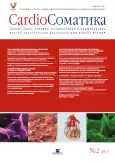Соль и артериальная гипертония. Возможности немедикаментозной профилактики артериальной гипертонии коррекцией питания в организованной популяции у мужчин и женщин от 25 до 49 лет в течение 3-летнего периода
- Авторы: Молчанова О.В.1, Бритов А.Н.1, Андреева Г.Ф.1
-
Учреждения:
- ФГБУ Государственный научно-исследовательский центр профилактической медицины Минздрава РФ, Москва
- Выпуск: Том 4, № 2 (2013)
- Страницы: 52-57
- Раздел: Статьи
- URL: https://journals.rcsi.science/2221-7185/article/view/45026
- DOI: https://doi.org/10.26442/CS45026
- ID: 45026
Цитировать
Полный текст
Аннотация
Ключевые слова
Полный текст
Открыть статью на сайте журналаОб авторах
Ольга Викторовна Молчанова
ФГБУ Государственный научно-исследовательский центр профилактической медицины Минздрава РФ, Москва
Email: ovm-337@mail.ru
канд. мед. наук, вед. науч. сотр. лаб. применения амбулаторных диагностических методов в профилактике неинфекционных заболеваний ФГБУ ГНИЦ ПМ
Анатолий Николаевич Бритов
ФГБУ Государственный научно-исследовательский центр профилактической медицины Минздрава РФ, Москва
Email: anbritov@yandex.ru
д-р. мед. наук, проф., вед. науч. сотр. отд. вторичной профилактики хронических неинфекционных заболеваний ФГБУ ГНИЦ ПМ
Галлия Фатиховна Андреева
ФГБУ Государственный научно-исследовательский центр профилактической медицины Минздрава РФ, Москва
Email: galiya-61@mail.ru
канд. мед. наук, ст. науч. сотр. лаб. применения амбулаторных диагностических методов в профилактике неинфекционных заболеваний ФГБУ ГНИЦ ПМ
Список литературы
- World Health Organization – Primary prevention of essential hypertension report of a WHO Scientific Group. Geneva, Switzerland: World Health Organization; Technical Report Series 1982; 678.
- European Guidelines on cardiovascular disease prevention in clinical practice (version 2012). Eur Heart J 2012; 33: 1635–701.
- Guidelines for the management of arterial hypertension. Eur Heart J 2007; 28: 1462–536.
- Chobanian A.V., Bakris G.L., Black H.R. et al. Joint National Committee on Prevention, Detection, Evaluation, and Treatment of High Blood Pressure. National Heart, Lung, and Blood Institute; National High Blood Pressure Education Program Coordinating Committee: Seventh Report of the Joint National Committee on Prevention, Detection, Evaluation, and Treatment of High Blood Pressure. Hypertension 2003; 42: 1206–52.
- Kempner W. Treatment of hypertensive vascular disease with rice diet. Am J Med 1948; 4: 545–77.
- Alderman M.H., Cohen H, Madhavan S. Dietary sodium intake and mortality: the National Heath and Nutrition Examination Survey (NHANES I). Lancet 1998; 351: 781–5.
- He J, Klag M.J., Whelton P.K. et al. Migration,blood pressure pattern, and hypertension: the Yi Migrant Study. Am J Epidemiol 1991; 134: 1085–101.
- Forte J.G., Miguel J.M., Miguel M.J. et al. Salt and blood pressure: a community trial. J Hum Hypertens 1989; 3: 179–84.
- Intersalt: an international study of electrolyte excretion and blood pressure. Results for 24 hour sodium and potassium excretion. Intersalt Cooperative Research Group. BMJ 1988; 297: 319–28.
- Brown I.J., Tzoulaki I, Candeias V, Elliott P. Salt intakes around the world: implications for public health. Int J Epidemiol 2009; 38: 791–813.
- Graudal N.A., Hubeck-Graudal T, Jürgens G. Effects of low - sodium diet vs. highsodium diet on blood pressure, renin, aldosterone, catecholamines, cholesterol, and triglyceride (Cochrane Review). Am J Hypertens 2012; 25: 1–15.
- Vasan R.S., Larson M.G., Leip E.P. et al. Assessment of frequency of progression to hypertension in non - hypertensive participants in the Framingham Heart Study: a cohort study. Lancet 2001; 358: 1682–6.
- Vasan R.S., Larson M.G., Leip E.P. et al. Impact of high - normal blood pressure on the risk of cardiovascular disease. N Engl J Med 2001; 45: 1291–7.
- Appel L.J., Moore T.J., Obarzanek E et al. A clinical trial of the effects ofdietary patterns on blood pressure. DASH Collaborative Research Group. N Engl J Med 1997; 336: 1117–24.
- Elliott P, Stamler J, Nichols R et al. Intersalt revisited: further analyses of 24h sodium excretion and blood pressurewithin and across populations. Intersalt Cooperative Research Group. BMJ 1996; 312: 1249–53.
- Fitzsimons J.T. Angiotensin, thirst, and sodium appetite. Physiol Rev 1998; 78: 583–686.
- Dustan H.P., Tarazi R.C., Bravo E.L. Diuretic and diet treatment of hypertension. Arch Intern Med 1974; 133: 1007–11.
- Culter J.A., Follmann D, Elliott P and Suhl I. An overview ofrandomized trials of sodium reduction and blood pressure.Hypertension 1991; 17 Suppl. I, (1): 27–33.
- Gonzalez M.C., Cohen H.W., Sealey J.E. et al. Enduring direct association of baseline plasma renin activity with all - cause and cardiovascular mortality in hypertensive patients. Am J Hypertens 2011; 24: 1181–6.
- Furberg C.D. Public Health Policies: No Place for Surrogates. Am J Hypertens 2012; 25: 21.
- Sacks F.M., Svetkey L.P., Vollmer W.M. et al. Effects on blood pressure of reduced dietary sodium and the dietaryapproaches to stop hypertension (DASH) diet. N Engl J Med 2001; 344: 3–10.
- Cook N.R., Cutler J.A., Obarzanek E et al. for the Trials of Hypertension Prevention Collaborative Research Group. Long term effects of dietary sodium reduction on cardiovascular disease outcomes: observational follow - up of the trials of hypertension prevention (TOHP) BMJ 2007; 334: 885.
- Blackburn H. Primary Prevention of High Blood Pressure. A Population Approach. Ann Clin Res 1983; 16 (Suppl. 43): 11–7.
- National Institute for Health and Clinical Excellence (NICE). Guidance on the prevention of cardiovascular disease at the population level; http://guidance.nice.org.uk/PH25 (Access verified 14 July 2010).
Дополнительные файлы







